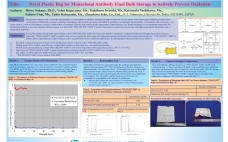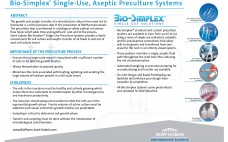Insect cell culture is widely used as an industrial platform in recombinant protein production for research and diagnostics (1, 3,4,5). Many commercial yeastolate products are intended as nutritional supplements for not only insect cell culture, but also for mammalian cell culture and bacterial fermentation applications (6,7,8,9,10,11,12,13,14,15). Yeastolate plays an important role in modern biological production because it can be very effective in promoting insect cell growth and enhancing production of recombinant proteins. The product is known to contain amino acids,…
Upstream Processing
A High-Yielding, CHO-K1–Based Transient Transfection System
Biotherapeutics have emerged as effective treatments for many diseases. It’s estimated that every year hundreds of new biotherapeutic candidates enter development (1). Stable transfection of host cells to establish high-producing cell lines is the approved method for generating clinical-grade recombinant biologics. However, biotechnology companies needing to speed up their developmental timelines are increasingly relying on material generated using transient transfection (1, 2). Unlike stable gene expression (SGE) that requires several months of laboratory and process work, transient gene expression (TGE)…
Analysis of Bacterial Biomass Growth and Metabolite Accumulation
Mathematical modeling has been widely used in microbiology and biotechnology for several decades. The main objective of modeling is to find optimal conditions for microbial growth and biosynthesis of useful metabolites. We modified the well-known equation of Perth–Marr (1) — proposed to calculate the energy consumption of a substrate— to analyze the energy consumption by cells for growth and viability maintenance. Our study includes that theory along with our own development. Our initial modeling work was carried out with Yersinia,…
Process Optimization of Biosimilars Production Using NMR Profiling
With a compound annual growth rate potential of ∼52% during 2010–2015 (1), the global biosimilars market represents a significant driver in biologics development and manufacture. Increased competition, quality-by-design (QbD) directives, and rising costs are compelling biosimilars manufacturers to search for advanced technologies they can use in optimizing production processes to remain competitive and maximize new opportunities. Here, we discuss biomanufacturers’ needs for robust, standardized cell-culturing procedures that comply with QbD directives. We also describe an effective new NMR-based bioanalysis technology.…
Improving Cell Culture Productivity with a SEGFLOW® Automated On-line Sampling and Feed System
A SEGFLOW® automated on-line sampling and feed system (SEGFLOW) was evaluated for its impact on Chinese Hamster Ovary (CHO) cell culture process performance in bench-scale stirred tank bioreactors. The SEGFLOW was integrated with a YSI® Biochemistry Analyzer and a nutrient feed pump allowing real-time glucose analysis and automated glucose feeding to be performed for the test batch. In contrast, a batch using daily manual sampling and bolus feed protocols, was performed as a control. For the SEGFLOW culture, media glucose…
Novel Plastic Bag for Monoclonal Antibody Final Bulk Storage to Actively Prevent Oxidation
Essentially, human protein such as monoclonal antibody is quite susceptible against oxidation. Nevertheless using the oxygen barrier containers, oxygen within the protein solution and oxygen leaking through the closure port of container affect to the protein. To minimize oxidation of monoclonal antibody, novel plastic bag for monoclonal antibody final bulk storage has been developed. The concept “Active” means that removing oxygen not only passively from the circumstances through the barrier layer within the container (or bag), but also actively removing…
Characterization of a Biomanufacturing Fermentation Process Using a New DOE Approach: Definitive Screening Designs
Traditionally, a bioprocess is characterized using a two-step approach involving factor screening designs followed by response surface designs. This approach is very costly and time consuming since it requires a significant number of runs. Recently, Jones and Nachtscheim (2011) described a more efficient design that allows for factor screening, resolution of two-way interactions as well as estimation of quadratic effects in a single-step. The design, termed Definitive Screening has not yet been validated on a bioprocess. Here, traditional and Definitive…
Bio-Simplex™ Single-Use, Aseptic PreCulture Systems
The growth and aseptic transfer of a microbial pre-culture from seed vial to bioreactor is a critical process step in the production of BioPharmaceuticals. The pre-culture step is performed in a biological safety cabinet or laminar flow hood, which adds time and significant cost and to the process. Saint-Gobain Bio-Simplexâ„¢ Single-Use Pre-culture Systems provide a sterile environment for cell culture and aseptic transfer of all fluids in and out of each cell culture vessel.
Attaining Next-Level Titers in CHO Fed-Batch Cultures
Taking full advantage of high cell-specific productivity of recombinant proteins requires use of robust fed-batch processes involving addition of one or more concentrated nutrient solutions. Proportionately large amounts of concentrated nutrient supplements are often needed to support the stoichiometrically balanced metabolic requirements of high-density cell cultures. Large feed additions ultimately dilute the final product at harvest, but attempts to minimize feed volumes often lead to multiple concentrated acidic and basic subgroups. Those impart additional complexity to manufacturing processes.…
A Host Cell Protein Assay for Biologics Expressed in Plants
Host cell proteins (HCPs) can be present in significant amounts in biological products through copurification with a recombinant protein-drug substance. Purified active ingredients developed for human use must be free of all contaminants — including residual HCPs — to minimize the incidence of immunogenicity against a drug product or its trace contaminants (1). HCP assays allow for monitoring host-related impurities during product development and process development. Most are in the enzyme-linked immunosorbent assay (ELISA) format for detecting…




